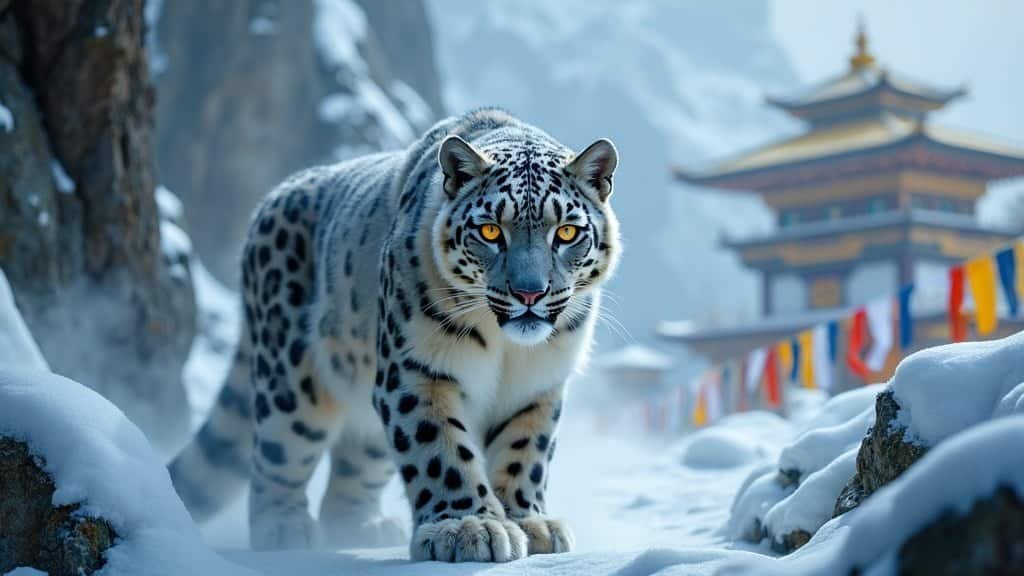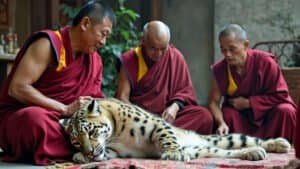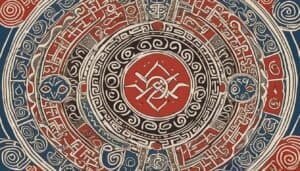Introduction
Snow leopards hold a deep cultural and spiritual significance in Bhutan, often symbolizing mystical power and spiritual guardianship in the Himalayas. From ancient folklore to religious traditions, these elusive creatures are revered as sacred beings with strong ties to Bhutan’s natural environment
This article delves into the legends, myths, and spiritual beliefs surrounding snow leopards in Bhutan, exploring their portrayal in folklore, religious practices, and the ways they are woven into the fabric of Bhutanese culture
Additionally, we’ll examine local perspectives and the conservation efforts that reflect the profound cultural value of these majestic animals
Cultural Significance of Snow Leopards in Bhutan
Snow leopards are more than just elusive predators in Bhutan; they are deeply woven into the cultural fabric of the country. Revered for their mysterious presence in the high altitudes of the Himalayas, snow leopards have long been symbols of spiritual power and protection in Bhutanese culture
The animal’s stealthy nature and ability to thrive in harsh, remote environments have inspired a range of myths and legends that highlight its importance beyond just a natural predator
Bhutanese Folklore and the Snow Leopard
In Bhutanese folklore, the snow leopard is often portrayed as a guardian of the mountains. These majestic animals are believed to protect the sacred peaks and the people who live in their shadow
The snow leopard’s presence is seen as a blessing, ensuring the balance between the natural world and the spiritual realm. Stories passed down through generations tell of snow leopards guiding lost travelers to safety or serving as omens of good fortune for those who encounter them
One popular legend speaks of a snow leopard that led a wandering monk to a hidden valley, where he established a monastery that still stands today. This story reflects the belief that snow leopards are not merely animals but spiritual guides who help connect the physical and spiritual worlds
This connection is further emphasized in the way snow leopards are often depicted in Bhutanese art, where they are shown as protectors of the land and people
Snow Leopards as Spiritual Guardians
The spiritual significance of snow leopards in Bhutanese culture is profound. They are considered to be the earthly manifestations of protective deities known as dharmapalas, who are fierce guardians of Buddhism
These deities are believed to protect the faithful from evil spirits and ensure the well-being of the land. The snow leopard, with its elusive and powerful presence, is seen as a living embodiment of these protective forces
In many Bhutanese religious texts and rituals, snow leopards are invoked as protectors. Monks often meditate on the image of a snow leopard to gain strength and courage, believing that the animal’s qualities can be transferred to them through focused contemplation
The leopard’s ability to navigate the harsh mountain terrain with grace and power is seen as a metaphor for spiritual resilience and strength in the face of life’s challenges
Symbolism in Bhutanese Religious Traditions
Snow leopards also hold a symbolic place in Bhutanese religious traditions. In Vajrayana Buddhism, which is widely practiced in Bhutan, the snow leopard is associated with the bardo—a transitional state between death and rebirth
The leopard’s solitary and mysterious nature is seen as a reflection of the journey the soul takes through the bardo, where it must navigate challenges and uncertainties before reaching enlightenment
The animal’s white coat, often tinged with shades of grey and black, symbolizes purity and the ability to blend into one’s surroundings, much like a practitioner who has achieved a high level of spiritual attainment
In some rituals, the snow leopard’s imagery is used to invoke qualities such as invisibility, precision, and the ability to move undetected—traits that are highly valued in both spiritual practice and in the challenges of everyday life
Furthermore, the snow leopard’s presence in the high mountains, close to the sky, is symbolically significant in a country like Bhutan, where the mountains themselves are considered sacred
The animal’s home in these remote, often unreachable areas reinforces its status as a creature of spiritual significance, living on the boundary between the earthly and the divine
Myths and Legends of Snow Leopards in Bhutan
Snow leopards have inspired numerous myths and legends in Bhutan, where they are often portrayed as mystical beings with powers that transcend the natural world. These stories have been passed down through generations, shaping the cultural and spiritual landscape of Bhutan
The reverence for these majestic creatures is reflected in the rich oral traditions and artistic expressions that continue to celebrate the snow leopard’s mysterious presence in the mountains
Famous Bhutanese Stories Featuring Snow Leopards
One of the most famous legends in Bhutan involves a snow leopard and a lama (a Buddhist monk). The story goes that a lama, meditating in a remote mountain cave, was visited by a snow leopard. Initially fearful, the lama soon realized that the leopard was not there to harm him but to protect him
Over time, the snow leopard became the lama’s constant companion, guiding him through difficult spiritual trials and helping him achieve enlightenment. This story emphasizes the snow leopard’s role as a spiritual guide and protector in Bhutanese culture
Another popular tale tells of a snow leopard that protected a village from a marauding demon. The demon, intent on destroying the village, was thwarted by the snow leopard, who engaged in a fierce battle to protect the people
The leopard’s victory ensured the safety of the villagers, who thereafter revered the animal as a divine protector. This legend is often recounted during local festivals, where snow leopard masks and dances symbolize the animal’s bravery and spiritual significance
Oral Traditions and Legends
In the oral traditions of Bhutan, snow leopards are often depicted as creatures with the ability to shape-shift or become invisible at will. These powers are believed to be a reflection of their spiritual nature, allowing them to move between the physical and spiritual worlds with ease
Some stories suggest that snow leopards can take human form, often appearing as wise elders who impart important lessons or guidance to those they encounter
These legends are not merely entertainment but serve as moral and spiritual teachings. They highlight the values of courage, wisdom, and spiritual strength, with the snow leopard often representing the ideal of a being that has mastered both the natural and spiritual realms
The tales are told by elders to younger generations, ensuring that the spiritual legacy of the snow leopard continues to influence Bhutanese society
Snow Leopards in Bhutanese Art and Literature
The mystical and revered status of snow leopards is also evident in Bhutanese art and literature
In traditional Bhutanese paintings, known as thangka, snow leopards are often depicted as companions of deities or as powerful creatures that embody spiritual qualities such as agility, strength, and wisdom. These paintings are not just artistic expressions but are used in religious rituals, serving as visual aids for meditation and spiritual practice
Literature in Bhutan also reflects the cultural significance of snow leopards. Poets and writers have long celebrated the snow leopard’s elusive nature and its symbolic connection to the mountains and the divine
In these works, the snow leopard is often a metaphor for the spiritual journey—solitary, challenging, and ultimately leading to higher understanding. The animal’s grace and power in navigating the treacherous mountain terrain are likened to the spiritual aspirant’s journey through the challenges of life toward enlightenment
Moreover, snow leopards appear in Bhutanese folklore as symbols of resilience and survival. Their ability to thrive in the harsh, unforgiving conditions of the Himalayas is admired and respected, making them a symbol of strength and endurance in the face of adversity
This respect is deeply ingrained in Bhutanese culture, where snow leopards are seen not just as animals but as embodiments of the spiritual qualities that are central to Bhutanese life
Spiritual Beliefs and the Sacred Nature of Snow Leopards
In Bhutan, snow leopards are revered not just for their physical beauty and elusive nature but also for their deep spiritual significance. They are seen as sacred beings that embody the connection between the natural and spiritual worlds
This belief is deeply ingrained in the spiritual practices and rituals of the Bhutanese people, where snow leopards are often considered as messengers or manifestations of divine beings
Snow Leopards as Sacred Animals in Bhutan
The sacred status of snow leopards in Bhutan is rooted in the country’s strong Buddhist traditions. Many Bhutanese believe that snow leopards are the earthly manifestations of deities or dharmapalas—protective spirits that guard the faithful and the land
These beliefs are particularly strong among the communities living in the remote mountainous regions, where snow leopards are most commonly found
Snow leopards are often regarded as symbols of purity and spiritual power. Their solitary existence in the high mountains, far from human settlements, adds to their mystique and reinforces their status as sacred animals
The snow leopard’s ability to survive in such harsh, remote environments is seen as a reflection of its spiritual strength and resilience, qualities that are highly valued in Bhutanese culture
In many Bhutanese rituals, the snow leopard is invoked as a protective spirit. For instance, during religious ceremonies or when seeking blessings for a new venture, images of snow leopards may be used to call upon their protective powers
The animal’s presence is believed to ward off evil spirits and bring good fortune to those who honor it
The Role of Snow Leopards in Bhutanese Spiritual Practices
The spiritual significance of snow leopards extends into the daily practices of Bhutanese Buddhism. Monks and laypeople alike often meditate on the qualities of the snow leopard, such as its strength, agility, and ability to remain unseen
These qualities are seen as metaphors for the spiritual path, where one must navigate challenges with skill and perseverance while remaining humble and invisible to ego-driven desires
In some monasteries, there are specific meditation practices that involve visualizing snow leopards as protective deities. These practices are designed to help practitioners cultivate the qualities of the snow leopard within themselves, such as inner strength, clarity of vision, and the ability to move gracefully through life’s challenges
The snow leopard is also a symbol of the bardo, the intermediate state between death and rebirth, where the soul must navigate difficult terrain before reaching a new life
These spiritual practices highlight the deep connection between snow leopards and the spiritual beliefs of the Bhutanese people. The animal is not just a creature of the natural world but is seen as a guide and protector on the spiritual journey
This belief is reflected in the reverence shown to snow leopards, both in religious ceremonies and in the everyday lives of those who live in the shadow of the Himalayas
Connections to Bhutan’s Natural Environment
The sacred nature of snow leopards is also closely tied to Bhutan’s natural environment. The high mountains where snow leopards live are considered sacred in Bhutanese culture, often referred to as the abodes of gods and spirits
The snow leopard, as a resident of these sacred spaces, is seen as a guardian of the natural world, responsible for maintaining the balance between the physical and spiritual realms
This connection between snow leopards and the natural environment is reflected in the way Bhutanese people interact with their surroundings. There is a strong cultural emphasis on living in harmony with nature, and this extends to the treatment of snow leopards
Killing a snow leopard is considered a grave offense, not just because of the animal’s endangered status, but because it is seen as an act of spiritual desecration
Bhutan’s commitment to environmental conservation is also influenced by the spiritual significance of snow leopards. The government and local communities work together to protect the habitats of snow leopards, not only to preserve biodiversity but also to honor the cultural and spiritual values associated with these animals
This holistic approach to conservation is a reflection of Bhutan’s unique philosophy of Gross National Happiness, where the well-being of the environment is seen as integral to the well-being of the people
Community Perspectives and Conservation Efforts
Snow leopards, with their profound cultural and spiritual significance, are deeply respected by the communities living in the high-altitude regions of Bhutan
These communities, who share their habitat with these elusive predators, have developed unique perspectives on snow leopards that influence their attitudes toward conservation
Bhutan’s approach to protecting these majestic animals reflects the strong interplay between cultural reverence and practical conservation strategies, ensuring the survival of snow leopards in their natural habitat
Local Community Views on Snow Leopards
For many rural communities in Bhutan, snow leopards are seen as protectors and symbols of good fortune. The reverence for snow leopards is particularly strong in villages located near their habitats, where encounters with these animals, although rare, are considered auspicious
This respect is passed down through generations, with elders teaching younger members of the community about the importance of living in harmony with nature and respecting all living beings, including predators like snow leopards
Despite the potential threat snow leopards pose to livestock, which are a vital resource for these communities, there is a notable absence of animosity toward the animals. This is largely due to the cultural beliefs that regard snow leopards as sacred beings
Instead of viewing snow leopards as pests or dangers, many Bhutanese see them as part of the natural order, deserving of protection and respect. This attitude is reflected in the low incidence of retaliatory killings, a problem that is more common in other regions where large predators threaten livestock
Conservation Efforts and Cultural Values
Bhutan’s conservation efforts are deeply rooted in the country’s cultural and spiritual values. The government, in collaboration with local and international organizations, has implemented several programs aimed at protecting snow leopards and their habitats
These efforts are not just about preserving a species but are also seen as a way to maintain the cultural and spiritual integrity of Bhutan
One of the key components of Bhutan’s conservation strategy is the involvement of local communities. Recognizing the importance of these communities in the conservation process, the government has developed initiatives that promote coexistence between humans and snow leopards
For example, programs that provide financial compensation for livestock lost to snow leopards help reduce the economic burden on herders and prevent retaliatory killings. Additionally, community-based monitoring programs train local residents to track and report snow leopard sightings, making them active participants in conservation efforts
Another important aspect of Bhutan’s approach is the integration of traditional knowledge with modern conservation practices. Many communities possess a deep understanding of the local ecology, gained through generations of living in close proximity to snow leopards
This knowledge is invaluable for conservation efforts, as it provides insights into the behavior and movements of snow leopards that may not be captured by scientific research alone
The Future of Snow Leopards in Bhutan
The future of snow leopards in Bhutan looks promising, thanks to the country’s unique blend of cultural reverence and effective conservation strategies. However, challenges remain
Climate change poses a significant threat to the snow leopard’s habitat, as rising temperatures could reduce the availability of prey and force the animals to move to higher, less hospitable altitudes. Additionally, as Bhutan continues to develop, there is a risk that human-wildlife conflicts could increase, particularly as infrastructure projects encroach on previously undisturbed habitats
To address these challenges, Bhutan is continuing to adapt its conservation strategies. There is a growing emphasis on climate resilience in conservation planning, ensuring that snow leopard habitats are protected from the impacts of climate change
Efforts are also being made to educate the public about the importance of preserving Bhutan’s natural heritage, with snow leopards often highlighted as a symbol of the country’s commitment to environmental sustainability
The international community also plays a role in supporting Bhutan’s conservation efforts. Partnerships with global conservation organizations provide technical and financial support, helping Bhutan implement innovative solutions to protect snow leopards
These collaborations are crucial for ensuring that snow leopards continue to thrive in Bhutan, not just as a species but as a vital part of the country’s cultural and spiritual identity
Conclusion
Snow leopards in Bhutan are more than just a species to be conserved; they are deeply intertwined with the cultural and spiritual identity of the country
Revered as sacred animals, protectors, and symbols of spiritual strength, snow leopards hold a significant place in Bhutanese folklore, religious practices, and community life. The myths and legends surrounding these elusive creatures highlight their role as spiritual guides and guardians of the natural world
Bhutan’s approach to snow leopard conservation is a unique blend of cultural reverence and modern conservation strategies
By involving local communities and integrating traditional knowledge with scientific practices, Bhutan has created a successful model for protecting these majestic animals. However, challenges such as climate change and development pressures still threaten the future of snow leopards
Through continued commitment to conservation and the preservation of cultural values, Bhutan strives to ensure that snow leopards remain a vital and enduring part of its natural and spiritual landscape. The ongoing efforts to protect these animals reflect the deep respect and admiration that the Bhutanese people have for their wild guardians of the mountains










